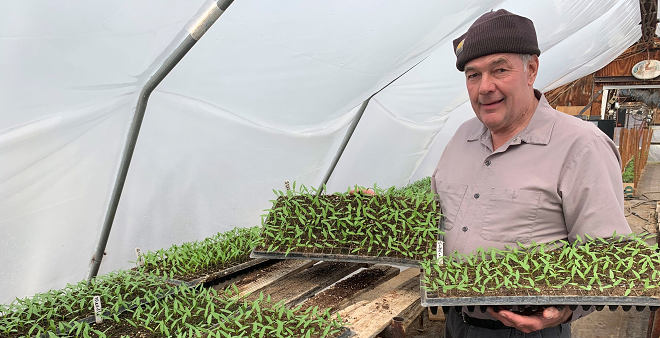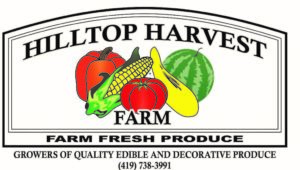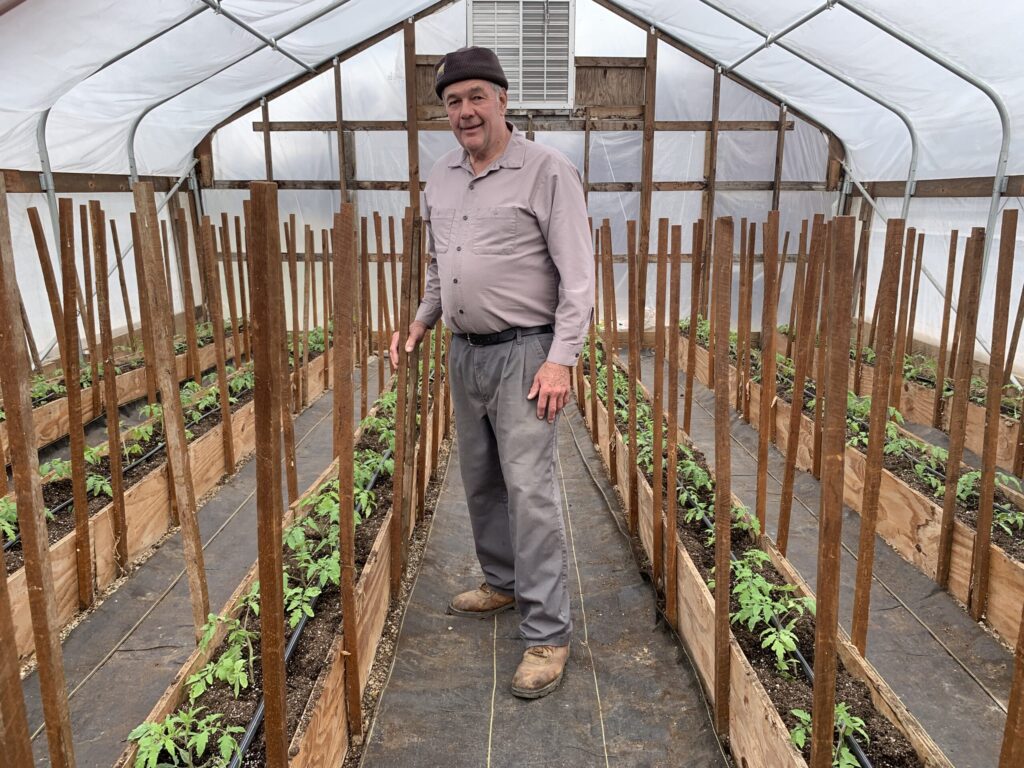

May 25, 2023Ohio grower finds direct sales financially, personally satisfying
A grain grower is finding success with marketing fresh produce directly to consumers after deciding to stop selling wholesale to retailers.
Tom and Tammy Brown’s Hilltop Harvest Farms in Wapakoneta, Ohio, grows a variety of vegetables. Tomatoes, cucumbers, hard squash, leafy greens, peppers and cantaloupes are the western Ohio farm’s biggest items.
Of his 250 acres, which include grains, Tom Brown grows produce on seven to nine acres, which varies seasonally.


Strawberries, tomatoes, melons, sweet corn and pumpkins are big draws for shoppers visiting farm stands.
The tomatoes Brown grows in high tunnels can be ready for harvest a month earlier than field-grown and draw customers in sooner. Growing tomatoes that way, and planting other vegetables in raised beds, required a change of mindset which involves different varieties and different timings of fertility and irrigation.
“Some will freak out about this, but we do not rotate our high tunnels,” Brown said of his four tunnels.
The reason is financial. Ideally, he could add a fifth tunnel, and rotate with cucumbers, but Brown said he has always fared well with his system. He runs drip irrigation for five days to leach salt out of the beds.
“Old-timers would say we have to take plastic off in the winter,” Brown said. “Well, no, we don’t.”
Removing plastic becomes expensive because it never returns the same way, he said.
All of Brown’s cucumbers are grown on trellises in raised beds with none lying flat.
“That’s the best way to deal with the plant disease, the downy powdery mildews that affect cucumbers,” he said. “You can put fungicides on and you will gain some, but you will lose that plant in Ohio.”
Brown plants cucumbers four times during the season. Similar to his tunnel tomatoes, yields are up to 2.5 times higher on the trellises.
To protect plants from wind, Brown has experimented with growing peppers in trellises and would like to grow more that way, but it’s about labor availability.
Soil factor
Soil health is critical for sustainability. Cover crops can help with soil if they can be worked into a grower’s rotation.


Brown periodically sets aside a 2- to 4-acre section for a year and seeds it with sudan grass in the spring. Mowing and plowing returns a boost of organic matter into the soil.
Occasionally, if a crop comes off early, Brown will plant buckwheat, which provides some extra organic material.
“On a small scale, it’s hard to work cover crops in when you grow intensively,” he said. “Organic matter is the key when it comes to sustainability. Nothing is more important than that.”
Brown’s family dairy farmland dates to the early 1900s. As a sophomore in high school in 1972, he began renting ground and later ran his own dairy farm and grew alfalfa hay. In the 1980s, declining markets for grain, dairy herds and horses prompted Brown to experiment with vegetables. He grew decorative market pumpkins, a hot trend then.
With no other growers within 50 miles growing fruits and vegetables, Brown realized he could make some money growing produce.
“For someone to grow something other than corn, soybeans and wheat in this area, they consider you to be crazy,” he said. “Sane farmers don’t grow those. They grow grains.”
Produce farmers grow food people can form a connection with.
“Anyone in direct marketing has to be able to talk to the consumer,” Brown said. “It’s really neat being able to grow a good product and talk with people about it and see them enjoy it and want to come back for more. In grain farming, you grow it, put it in a bin, load it in a truck and it’s gone.”
While Brown initially increased his pumpkin acreage, he stopped growing them in the late 1990s when labor costs exceeded returns. Many other growers had entered the deal.
Make-or-break philosophy
Brown’s philosophy is that a grower should try a crop for at least three years. If one can’t be successful in that time, he shouldn’t grow it.
Cantaloupe wasn’t initially successful.
“I’ve never been so attached to a crop that I won’t walk away from it,” Brown said. “It has to make money. It’s important for everyone to keep in mind, especially the smaller growers, don’t be so entrenched on a crop that you keep growing it even though you aren’t making any money on it.”
Last year, Brown began watering lettuce, which he begins harvesting in the early spring ahead of tomatoes, via overhead intermittent misters. The misting aids plants when temperatures exceed 85° Fahrenheit. Automatic misting, added this year, saves on labor.
After switching to drip tape, Brown applies half of the fertilizer onto the pepper ground and his tunnel tomatoes before laying plastic.
In 2000, Brown exited the wholesale market. Tight margins and regional grocery chains’ new owners not buying locally prompted major growing adjustments. By selling directly, however, Brown grows on a fourth of his previous acres, but earns three times the profit.
Situated on U.S. 33, the main thoroughfare from Columbus, Ohio, to Fort Wayne, Indiana, Brown draws many people passing through, with some on family journeys. They tell him they can’t find such quality produce.
Earlier in his life, Brown worked with his uncles in a fabrication shop. Those metal skills come in handy in the produce business when he wants to modify or construct new farm equipment.
During good years like the last five years, Brown has learned to pay off bills and repair and replace equipment ahead of lean times.
“It doesn’t matter what crop or livestock you grow or raise,” he said. “The really good times are the times to prepare for tight times.”
— Doug Ohlemeier, assistant editor
Top photo: Tom Brown of Hilltop Harvest Farms in Wapakoneta, Ohio, is finding success selling directly to consumers. Photos courtesy of Hilltop Harvest Farms.














